Day 3 of a long weekend of Early Winter Tours today, our last day. It was another frosty start and another glorious, clear, sunny day. There was a light but fresh westerly breeze in the morning but that dropped by the afternoon. Another great day to be out birding!
Today we headed out in the other direction, west along the coast road. As we passed Holkham we could see lots of Pink-footed Geese in the grazing meadows beyond Lady Anne’s Drive. A small group was close to the road, so we pulled up by a convenient gap in the hedge for a closer look. We could see their small bills, mostly dark but for a narrow pink band, and their dark heads.
 Pink-footed Goose – a group was right by the coast road as we passed by
Pink-footed Goose – a group was right by the coast road as we passed by
A little further on, we stopped to have a look out across the freshmarsh. A large white shape flew across the front edge of one of the pool and landed in the rushes. Even at that distance, it was clearly a big heron and could only be a Great White Egret. Through the scope we could see its long, yellow dagger of a bill. A Grey Heron appeared next to it and was not much smaller – a nice size comparison. Then a second Great White Egret appeared on the front edge of the trees out in the middle.
There were a few geese out on this end of the freshmarsh today, mostly Greylags but with a few small groups of pairs of Egyptian Geese scattered among them too. Looking through them carefully, we managed to find a group of three White-fronted Geese in with the Greylags down at the front of the grass. Through the scope, we could see the white-surround to the base of their pink bills. When something flushed the geese and they resettled, more White-fronted Geese had appeared – there was now a tight group of at least thirteen together a little further out.
 White-fronted Geese – at least 13 were at Holkham today
White-fronted Geese – at least 13 were at Holkham today
A handful of Pink-footed Geese out on the freshmarsh here too included a single bird bearing a silvery grey neck collar. We could just read the lettering ‘VLS’ through the scope. It will be interesting to hear back where it has been seen before. There still don’t seem to be so many Wigeon here, but we could still see several flocks over in the distance around the pools to the east. It seems like it has still been rather mild on the continent and numbers of some wildfowl are still rather low. More should arrive in the coming weeks.
A nice selection of raptors put on a show for us this morning. A Red Kite drifted in from over the Park behind us and dropped down towards the grazing marshes. It appeared to land on the grass behind the trees and a Marsh Harrier flew straight in after it. The Red Kite promptly reappeared the other side of the trees, presumably seen off from whatever it had found. Its rusty red tail and underparts positively shone in the morning sun as it banked and turned.
A couple of Common Buzzards were perched out in various trees and bushes. One was a fairly conventional brown bird, but the other was strikingly pale, white below and around the head. As the air started to warm a little, more Marsh Harriers and Buzzards appeared in the air. A Sparrowhawk flew in along the line of the hedge below us amd chased out a second one. The two Sparrowhawks then landed in a tree where we could get them in the scope. A Kestrel was perched on the scaffold tower in the distance.
Continuing on our way west, we stopped again at Brancaster Staithe. A Long-tailed Duck had been reported for the last couple of days in the harbour channel here and it didn’t take us long to find it. It was diving further out in the channel, among the boats at first, but then swam up the channel past us and disappeared into the mouth of one of the muddy creeks.
There were lots of waders around the muddy edges of the creek. Several Bar-tailed Godwits gave us a great opportunity for closer inspection and a discussion of some of the differences between the two godwit species in non-breeding plumage. We could hear a Greenshank calling and quickly located it on the far bank in the sunshine, before a second Greenshank flew in and joined it.
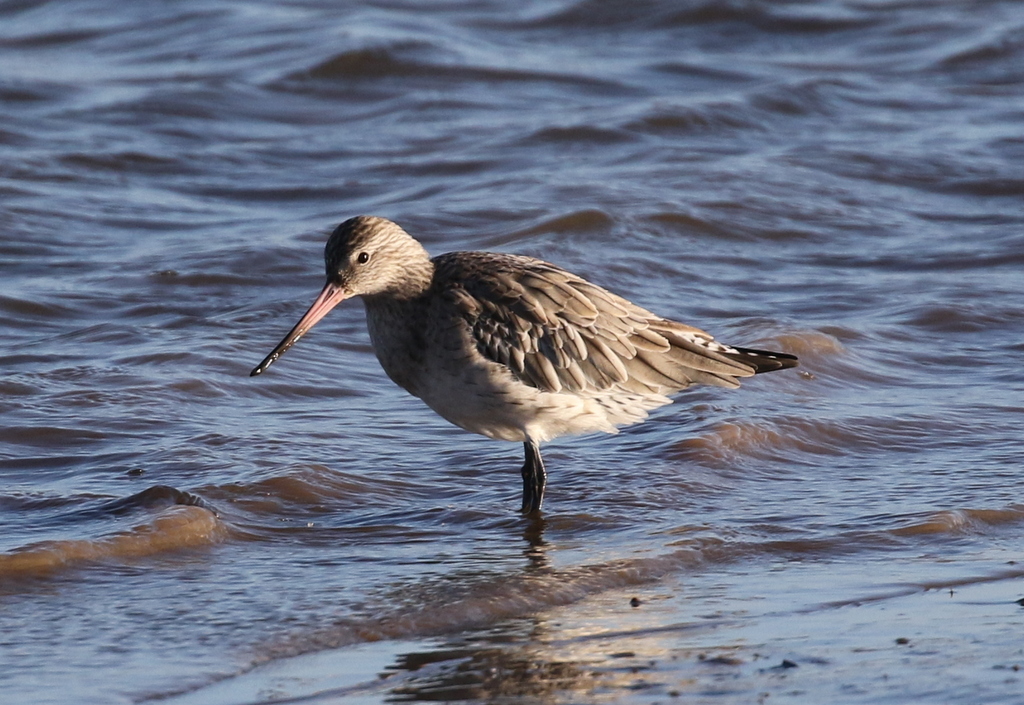 Bar-tailed Godwit – close views at Brancaster Staithe this morning
Bar-tailed Godwit – close views at Brancaster Staithe this morning
There were also a few Dunlin down with the Bar-tailed Godwits and a Ringed Plover on the near edge. Further over, we could see a couple of Grey Plover and Curlew too. Several Turnstone were practically running around our feet until they spotted a Common Gull dropping a mussel, shattering it and then starting to pick it apart. They gathered round, waiting to pick off the scraps.
There were a few Brent Geese feeding round the harbour too, plus a scattering of Wigeon. A little group of Teal gathered down along the near edge of the harbour ramp looked stunning in the morning sunshine.
When the Long-tailed Duck reappeared, it was initially hard to follow. It was diving constantly and made its way even further up the channel away from us. But the tide was going out and it quickly turned back, swimming back down channel and straight past us, giving us a great close view as it went past. It was a first winter drake, rather pale around the head and with some pale feathering in the upperparts.
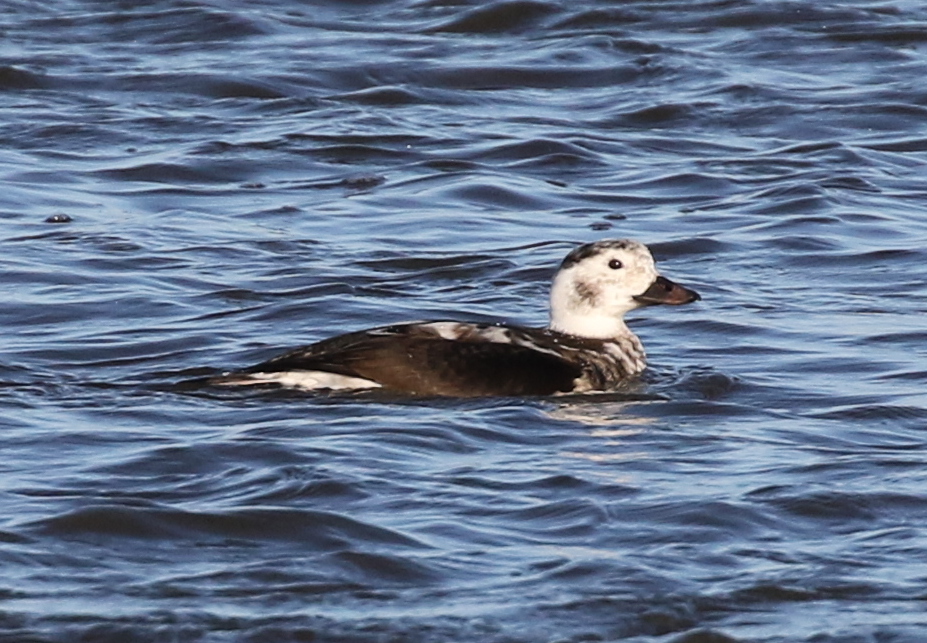 Long-tailed Duck – in the harbour channel at Brancaster Staithe
Long-tailed Duck – in the harbour channel at Brancaster Staithe
As the Long-tailed Duck swam back out into the open water downstream, we decided to move on. We made our way west to Thornham Harbour next. As we got out of the car, we saw a flock of small finches drop down towards the saltmarsh beyond the car park. We would come to those in a minute, but first we had a quick look in the harbour channel. There were a few waders down on the mud – Black-tailed and Bar-tailed Godwit and Common Redshank – but no sign of any Spotted Redshank here.
From up on the seawall, we quickly located the flock of small finches down on the saltmarsh and sure enough they were the Twite which we were looking for. They were feeding on the dry seedheads but were rather nervous as usual and kept flying up and circling round over the harbour before landing back down on the edge of the saltmarsh right in front of us again, back where they had started. We had a great look at them through the scope – their rich orangey-brown-toned breasts and bright yellow bills catching the sun when they perched up on the taller seedheads.
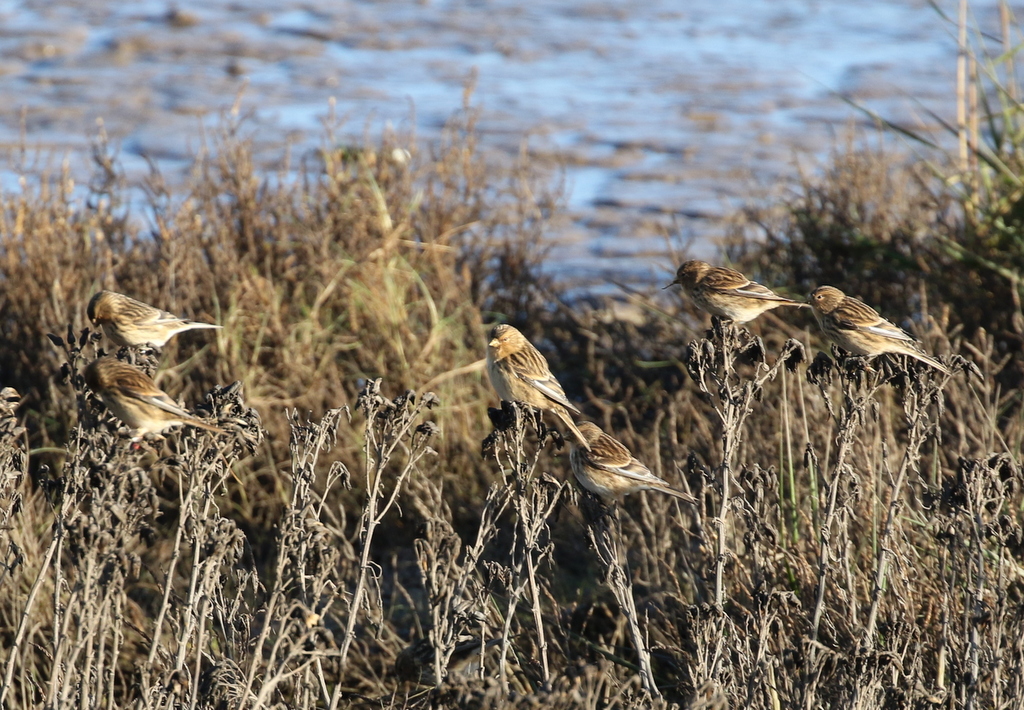 Twite – around twenty were feeding on the saltmarsh vegetation
Twite – around twenty were feeding on the saltmarsh vegetation
There are around twenty Twite here at the moment. This is a traditional wintering spot for the species, although numbers have declined markedly in recent years as the breeding population in the Pennines has declined, which is where most of our wintering Twite come from. There are always a few colour-ringed birds in with them, which help to confirm their origins.
Looking out across the harbour, we could see large flocks of Wigeon and Brent Geese in the distance. A single Red-breasted Merganser was just visible way out in a chink of open water where the harbour channel curved towards the sea, before it swam behind one of the sandbanks out of view. A Curlew was catching the sun down in the muddy channel just below the bank.
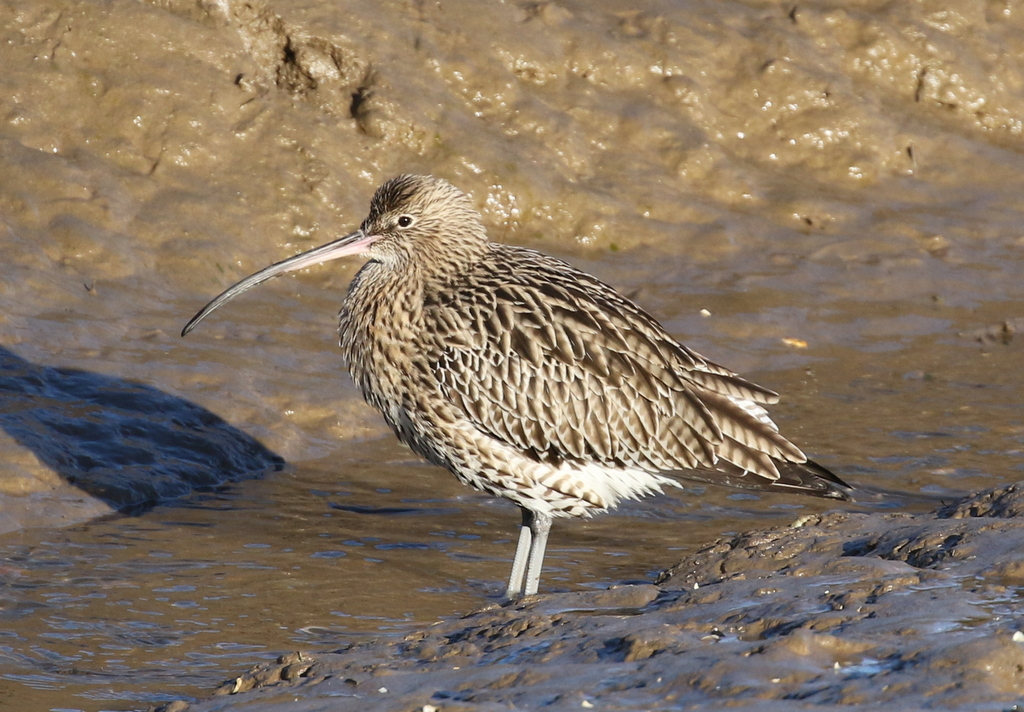 Curlew – warming itself in the morning sun
Curlew – warming itself in the morning sun
Continuing on out along the seawall, there were lots of Skylarks on either side, over the grazing meadows and the saltmarsh. A couple of Reed Buntings flew in and landed down amongst the Suaeda bushes just below the bank. A single Common Snipe flew in and landed out in the grass briefly, before heading back out across the saltmarsh. The Twite flew over our heads calling and landed down by a pool out on the grazing marsh for a quick drink, before flying back towards the harbour again.
We stopped for a quick look out across Broadwater. A Little Grebe and a few Coot were both new birds for the day, but otherwise there were just a few dabbling ducks around the reedy margins – mainly Mallard, Teal and Shoveler. In the grazing meadow beyond, a party of Brent Geese had flown in to join the local Greylags feeding on the grass.
Climbing up into the dunes, we had a look out to sea. The Common Scoter were very distant today and very spread out – we could just make out hundreds of tiny dark specks riding the waves out towards the horizon. A pair of Red-breasted Merganser flew in and landed behind the breakers. Otherwise, there was not much visible out on the sea today – just a couple of Great Crested Grebes.
When we got back to the harbour, we had another quick look in the harbour channel. A couple of Rock Pipits were chasing each other around on the mud and up onto the boats moored along the wooden jetties. There was still no sign of any Spotted Redshanks though, until we had started to leave and we spotted one further up the channel from the car. We got out and got the scope on it – we could see its long, needle-fine bill. It was also noticeably paler than the Common Redshank on the mud behind it. The Spotted Redshank was feeding in the water at first, sweeping its bill quickly from side to side, before it climbed out onto a line of rocks and stood where we could see its red legs.
With a bit of time still before lunch, we headed inland for a drive round to see if we could find any flocks of finches and buntings in the fields. We did find a lot of Blackbirds and thrushes feeding on the berries in the more overgrown hedges – including several Redwings and a couple of Fieldfares too.
A little further on, we came across a large flock of finches, coming down to drink in the puddles around a farm gateway. They were mostly Chaffinches, plus a few Goldfinches and one or two Greenfinches, but a smart male Brambling flew up too and landed in the hedge just in front of us. We could see its orange breast and shoulders, and its white rump as it eventually flew away ahead of us down the line of the hedge.
Dropping back down via Choseley, we passed a large mixed flock of Linnets and Goldfinches feeding in a strip of wild bird seed mix sown along the margin of a field. There was very little around the drying barns though – just a handful of House Sparrows feeding on some seed scattered in the layby. A group of Golden Plover was feeding in a winter wheat field along with some Lapwings further down.
As we got out of the car in the car park at Titchwell, a single Chiffchaff was feeding in the sunshine in the yellow autumn leaves of a sycamore. We stopped for lunch in the picnic area, and quickly picked out one of the Mealy Redpolls here, feeding up in the alders with the Goldfinches. We had a chat about the changing taxonomy of the Redpoll complex over lunch – the treatment of these birds is currently in a state of flux, to say the least! A flock of Long-tailed Tits passing through, along with a Goldcrest provided a welcome distraction.
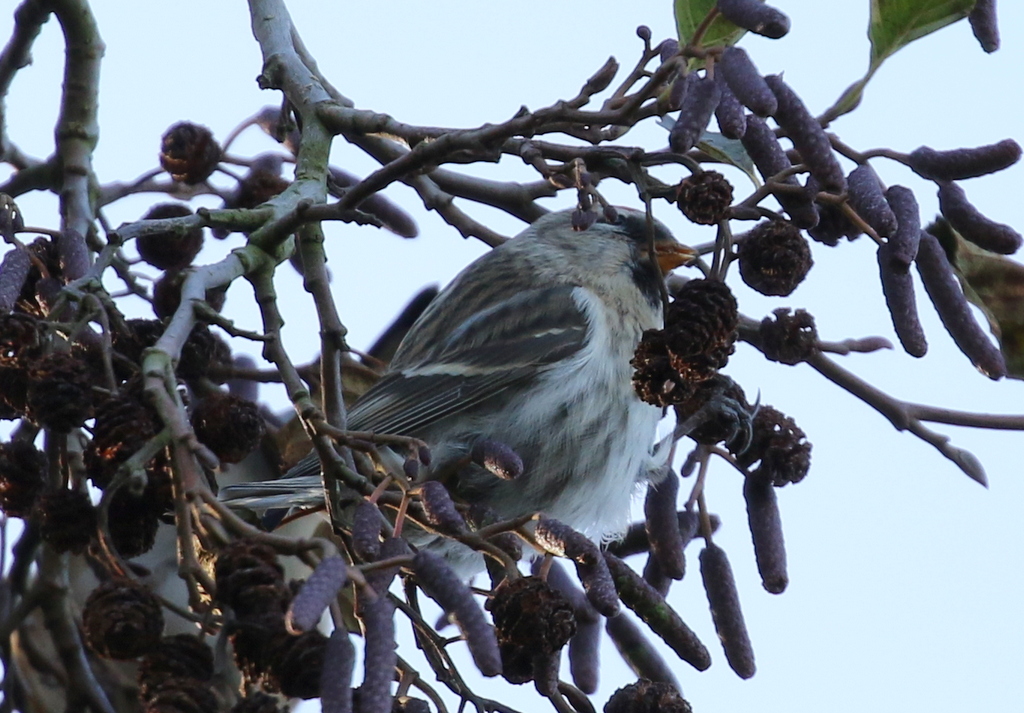 Mealy Redpoll – feeding up in the alders above the picnic area
Mealy Redpoll – feeding up in the alders above the picnic area
After lunch, we headed out to explore the reserve. The feeders around the visitor centre were looking rather empty this afternoon. A Coal Tit was a welcome addition to the day’s list, but otherwise there were just a few Chaffinches and Blue and Great Tits. We could hear a couple of Siskin calling from somewhere high in the willows.
A careful scan of the ditches along the path provided a Water Rail feeding quietly down in the wet leaves in the bottom. Unfortunately, as more people gathered around us and started chatting noisily, it scuttled back into cover, although we could still see it feeding under the branches of an overhanging tree.
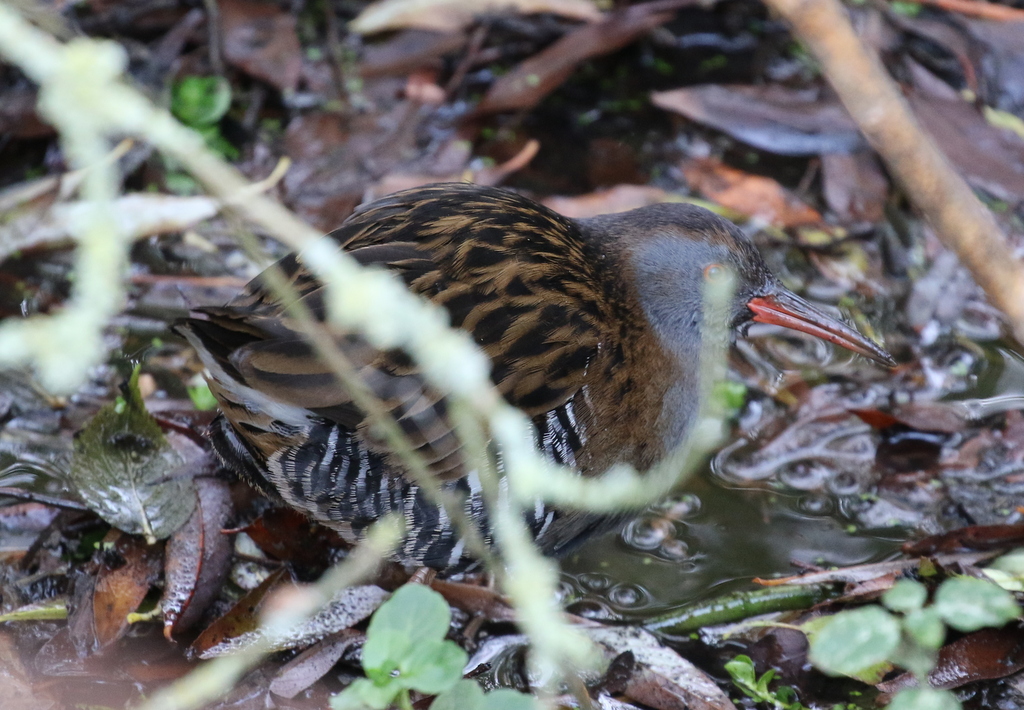 Water Rail – feeding down in the ditch below the path
Water Rail – feeding down in the ditch below the path
There were just a few Mallard and a single Little Grebe out on the reedbed pool and we couldn’t see any activity on the dried up grazing meadow ‘pool’, so we headed straight out to the freshmarsh. A couple of Cetti’s Warblers sang from the bushes out in the reeds as we passed. A Kestrel was perched on the concrete bunker out on the saltmarsh and as we looked at it through the scope a Kingfisher appeared briefly, hovering behind.
There were lots of birds out on the freshmarsh, particularly ducks here for the winter. There are plenty of Wigeon here now and lots of Teal. We got a smart drake Gadwall in the scope and admired the subtle patterning of its plumage. There were a few Shoveler and Shelduck out there too.
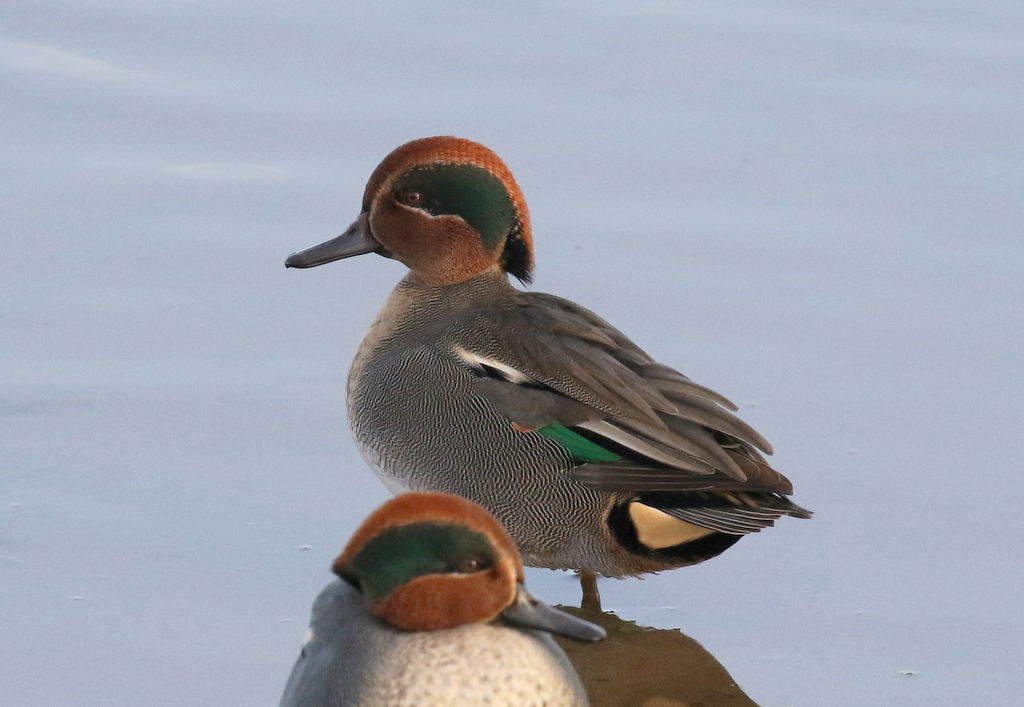 Teal – good numbers on the freshmarsh for the winter now
Teal – good numbers on the freshmarsh for the winter now
A small gathering of gulls around one of the small islands were mostly Black-headed and Herring Gulls, but we did find an adult Yellow-legged Gull in with them. Unfortunately it was swimming on the water and it was impossible to see its custard yellow legs!
There was not a great variety of waders on view, but we could see a good number of Ruff here. One of the Ruff was still in full juvenile plumage, much darker than the others. It was also a female and noticeably smaller than the paler winter adult male it was next to. There were also a few Dunlin out on the mud amongst all the ducks.
There was a better selection of waders out on the Volunteer Marsh today. From the corner by the path to Parrinder Hide we stopped to scan. We could see Bar-tailed Godwit, Curlew, Dunlin, Grey Plover and Redshank. A Ringed Plover was feeding on the mud just the other side of the channel, with three more further back. A single Knot was picking around the islands of vegetation out in the middle.
 Ringed Plover – there were several on Volunteer Marsh today
Ringed Plover – there were several on Volunteer Marsh today
There were a few Black-tailed Godwits along the tidal channel at the far side of the Volunteer Marsh, including one on the mud just below the path which gave us a good opportunity to have a closer look at it, reminding ourselves of the differences from the Bar-tailed Godwits we had seen earlier. Most of the Avocets have departed for the winter, but we did find one lonely individual roosting on the spit out on the tidal pools. Otherwise, a single drake Pintail and a Little Grebe were the only other birds of note on here today.
The tide was already on its way in when we got out to the beach. We could see lots of Oystercatchers still down on the bits of the mussel beds which had not yet been covered by the water. We got a Sanderling in the scope, running around on the edge of the sea, dwarfed by an Oystercatcher next to it. The waders were starting to gather ahead of the rising tide and a large flock of forty or so Sanderling then flew in from the west, along with a big party of Bar-tailed Godwits.
Out on the sea, we found a Common Scoter close in, riding the waves just behind the breakers – a better view than the distant dots we had seen earlier! But other than a few more Common Scoter, we couldn’t see anything else on the sea today. There were lots of gulls out on the beach, feeding on razor shells washed up along the tide line, but a quick scan through them failed to locate anything other than the regular species.
We stopped in at Parrinder Hide on our way back. There were more gulls arriving all the time, coming in before roost – Herring Gulls, Lesser Black-backed Gulls and Black-headed Gulls. We found the Yellow-legged Gull again, asleep now, but at least we could see half its custard yellow legs above the water now.
There were a few more waders gathering too. There was already a little party of Golden Plover on the edge of one of the islands in front of the hide. As we sat and watched, every few minutes another small group would drop in and join them, calling plaintively as they flew in from the fields inland where they had been feeding. A single Knot had appeared on the edge of the gathered Black-headed Gulls and a flock of Turnstone flew in from the beach. There were a few more Black-tailed Godwits on here too now and the Ruff had gathered together into a tighter flock ready to roost.
 Golden Plovers – gathering on the freshmarsh at dusk
Golden Plovers – gathering on the freshmarsh at dusk
The light was starting to go fast now – the evenings draw in quickly at this time of year. As we made our way back towards the visitor centre, we stopped on the path opposite the reedbed. The Marsh Harriers were gathering to roost over the reeds, and we counted at least 11 before we left, flying round and perched in the bushes. A twelfth then flew in overhead from the direction of Thornham as we walked on.
It was getting dark as we drove back towards Holkham. As we drove along the north side of the park, we could see lines and lines of geese flying overhead in the gathering gloom, thousands of Pink-footed Geese dropping down to the freshmarsh to roost. A typical Norfolk sight at this time of year and a nice way to end the day – and an action-packed three days of early winter birding.
















